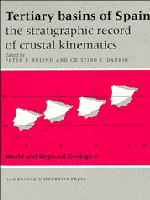Book contents
- Frontmatter
- Contents
- List of contributors
- Preface
- Dedication to Professor Oriol Riba IArderiu
- Memorial, Etienne Moissenet 1941–1994
- PART G GENERAL
- PART E EAST
- PART W WEST
- PART C CENTRE
- C1 Structure and Tertiary evolution of the Madrid basin
- C2 Neogene tectono-sedimentary review of the Madrid basin
- C3 Sedimentary evolution of lake systems through the Miocene of the Madrid Basin: paleoclimatic and paleohydrological constraints
- C4 Paleomorphologic features of an intra-Vallesian paleokarst, Tertiary Madrid Basin: significance of paleokarstic surfaces in continental basin analysis
- C5 Tectono-sedimentary analysis of the Loranca Basin (Upper Oligocene–Miocene, Central Spain): a ‘non-sequenced’ foreland basin
- C6 Paleoecology and paleoclimatology of micromammal faunas from Upper Oligocene – Lower Miocene sediments in the Loranca Basin, Province of Cuenca, Spain
- C7 Fluvial fans of the Loranca Basin, Late Oligocene – Early Miocene, central Spain
- C8 Saline deposits associated with fluvial fans, Late Oligocene – Early Miocene, Loranca Basin, Central Spain
- C9 Shallow carbonate lacustrine depositional controls during the Late Oligocene – Early Miocene in the Loranca Basin (Cuenca Province, central Spain)
- PART S SOUTH
- Index
C3 - Sedimentary evolution of lake systems through the Miocene of the Madrid Basin: paleoclimatic and paleohydrological constraints
Published online by Cambridge University Press: 04 August 2010
- Frontmatter
- Contents
- List of contributors
- Preface
- Dedication to Professor Oriol Riba IArderiu
- Memorial, Etienne Moissenet 1941–1994
- PART G GENERAL
- PART E EAST
- PART W WEST
- PART C CENTRE
- C1 Structure and Tertiary evolution of the Madrid basin
- C2 Neogene tectono-sedimentary review of the Madrid basin
- C3 Sedimentary evolution of lake systems through the Miocene of the Madrid Basin: paleoclimatic and paleohydrological constraints
- C4 Paleomorphologic features of an intra-Vallesian paleokarst, Tertiary Madrid Basin: significance of paleokarstic surfaces in continental basin analysis
- C5 Tectono-sedimentary analysis of the Loranca Basin (Upper Oligocene–Miocene, Central Spain): a ‘non-sequenced’ foreland basin
- C6 Paleoecology and paleoclimatology of micromammal faunas from Upper Oligocene – Lower Miocene sediments in the Loranca Basin, Province of Cuenca, Spain
- C7 Fluvial fans of the Loranca Basin, Late Oligocene – Early Miocene, central Spain
- C8 Saline deposits associated with fluvial fans, Late Oligocene – Early Miocene, Loranca Basin, Central Spain
- C9 Shallow carbonate lacustrine depositional controls during the Late Oligocene – Early Miocene in the Loranca Basin (Cuenca Province, central Spain)
- PART S SOUTH
- Index
Summary
Abstract
Miocene sedimentary successions of the Madrid Basin, central Spain, contain well-developed lake complexes that show distinctive facies associations through time. Lake systems formed during the Ramblian and Early Aragonian (Lower Unit) were predominantly evaporite lakes in which highly soluble salts precipitated. During the Middle to Late Aragonian and Vallesian (Intermediate Unit), sedimentation in the lakes was dominated by carbonate and gypsum. An expansion of fresh-water carbonate lakes is recorded towards the top of the unit. During the Turolian (Upper Unit), lacustrine sedimentation took place in a network of interconnected shallow carbonate lakes and fluvial subenvironments. In this paper we discuss the correlation or agreement between the paleoclimatic interpretation that can be inferred from lithofacies analysis and that furnished by mammal assemblages evolving throughout the Miocene in the Iberian Peninsula. Our results indicate that other factors besides climate (e.g., tectonics, source areas, and paleohydrological regimes) influenced decisively the nature of sediments in the lake complexes.
Introduction
Lacustrine sedimentary sequences can potentially provide a very powerful archive of paleoenvironmental evolution in continental basins. The sedimentary evolution of lake complexes through time can provide meaningful information about the record of past climate changes on at least local or regional scales (Talbot & Kelts, 1989). Climatic influence is usually expressed in terms of temperature (cool versus warm) and humidity (dry versus moist), both parameters controlling the input/output balance in lake systems.
- Type
- Chapter
- Information
- Tertiary Basins of SpainThe Stratigraphic Record of Crustal Kinematics, pp. 272 - 277Publisher: Cambridge University PressPrint publication year: 1996
- 11
- Cited by



